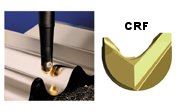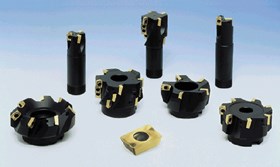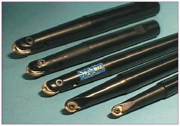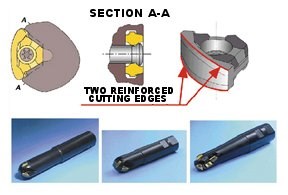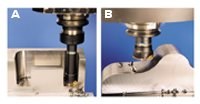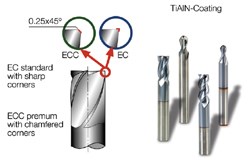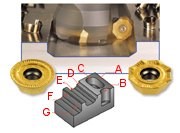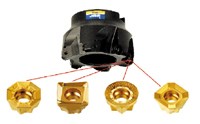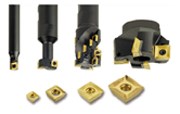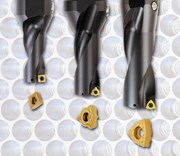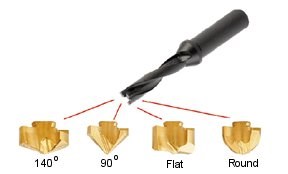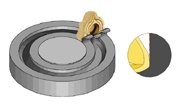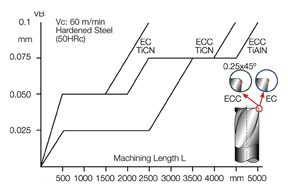How to Choose the Right Hardware for Your Software
MoldMaking Technology magazine conducted an informal survey to discover what is both the minimum and recommended hardware requirements that will work best with a moldmaker's CAD/CAM software.
The choice of hardware makes a crucial difference to the productivity of a CAD/CAM system. Overall, experts would agree that hardware becomes obsolete rather rapidly. Therefore, it is helpful to keep up-to-date on the changes and check first with CAD/CAM suppliers when looking to upgrade, or to check with power users, user groups or friends who are operating the same software. Minimum requirements mean that the software will run but it may be slow or it may have to be replaced or upgraded more quickly. Recommended requirements will be more expensive, but the performance will be better. The results of the survey are as follows.
Operating Systems
For operating systems, it appears that, at this time, Windowsr NT 4.0 is the optimum choice, followed closely by Windowsr 2000 Professional and Windows XP. Most CAD/CAM systems are available on Windowsr 95/98 editions, but according to some experts, those editions are not reliable or powerful enough. Some experts say that if a company must go with a minimum requirement, it would do better to choose Windows ME, Millenium Edition, because it provides more efficiency, organizational tools and security than Windowsr 95/98 versions. Others however, strongly disagree with this opinion and discourage its use. It would be best to discuss this subject with a CAD/CAM supplier before purchasing.
Processors
The Intelr Pentiumr III processor comes as the most highly recommended for running CAD/CAM software, although some experts believe it is becoming obsolete. Some other processor types recommended by experts are the Intelr Pentium 4, Intelr Xeon& and the AMD Athlon& XP. The most basic type required for a CAD/CAM system is the Pentiumr Pro, the Pentiumr Microprocessor and the Pentiumr II. According to Chuck Matthews, vice president of marketing for DP Technology (Camarillo, CA) - manufacturers of ESPRIT CAM software for the machine tool industry - both the Pentiumr III and the AMD Athlon& represent the middle ground in microprocessor performance - providing both good performance and good value. "Most individuals are more comfortable purchasing the brand name Intel and its associated security," Matthews claims.
Recommended processor speed is 800 MHz (megahertz) or better. The minimum is 500 MHz.
Memory
The more RAM (random access memory) you have, the more programs you can run. According to the respondents of this survey, today's operating systems require an average of 32 to 64 MB (megabytes) just to run. Although the minimum can go as low as 32 MB, it is evident from the responses that for optimum performance, the recommended amount would be closer to 512 MB and no less than 128 MB. One expert responded that 756 MB is ideal, however, it is best for a company to consider what its future requirements might be before making a final decision. Each upgrade of software usually requires more processor speed as well.
| Survey Participants (The following companies participated in this survey:) | |
| CADCAM-E.com (Farmington Hills, MI) Cadkey Corporation (Marlborough, MA) Clear-Cut Solutions (Addison, IL) Delcam (Windsor, Ontario) DP Technology (Cavarillo, CA) EDS PLM Solutions (Maryland Heights, MO) Engineering Geometry Systems (Salt Lake City, UT) Faro Technologies (Lake Mary, FL) Gibbs & Associates (Moorpark, CA) Hurco Machine Tool Products (Indianapolis, IN) Light Machines (Manchester, NH) MasterCAM/CNC Software (Tolland, CT) Moldflow Corporation (Wayland, MA) NC Graphics (Zionsville, IN) NC Micro (Richardson, TX) |
Open Mind Technologies (Southfield, MI) Paramount Industries (Langhorne, PA) Pathtrace Engineering Systems (Southfield, MI) Pleasant Precision, Inc. (Kenton, OH) R & B Mold & Design (Cave Creek, AZ) Renishaw (Hoffman Estate, IL) Roehr Tool Corp. (Hudson, MA) Sescoi USA (Southfield, MA) Softech (North Prairie, WI) Surfware, Inc. (Westlake Village, CA) Tebis (Troy, MI) Vero International (Mt. Morris, IL) Vision Numeric USA, Inc. (Norcross, GA) Weber (Brookfield, WI) |
Graphics
Graphic cards - also frequently referred to as video adapters - are essential to using CAD/CAM software. Experts suggest that graphics cards meet the following minimal requirements: Open GL support, AGP (Accelerated Graphics Port), 32 MB of memory and a Windowsr NT 4.0-compliant driver. 3Dlabs Oxygen GX1 with 32 MB is considered a good choice. The recommended is Elsa Gloria II or III or any utilizing the nVidia GeForce2 graphics chip with 32 MB video RAM. It also is recommended that users check with the manufacturer of the software for compatibility issues.
Hard Drive
The minimum requirements for hard disk size range from 30 GB to 50 GB. The hard disk drive or hard drive is the main location where all data is stored. For optimum performance, respondents recommended a hard disk size ranging from 10 GB to 80 GB. Overall, experts say that SCSI (small computer system interface) hard drives of 18 to 36 GB and EIDE (enhanced integrated device electronic) drives of 20 to 60 GB are the most common, but there are hard drive controllers that support much larger drives at higher speeds such as the Ultra-ATA 133. These are great controllers for stand-alone machines, but SCSI should be used if the data is being shared across a network. Keep in mind that disk space can be added as needed.
Other Essentials
A modem is necessary today, but experts encourage purchasers to follow five rules before purchasing a modem. Make sure that the phone line supports 56K, buy what the ISP uses, but be sure the modem supports V 90, buy a brand name modem and read the 56 Primer to avoid surprises. A CDDROM also is a good idea, say respondents, for both the minimum and recommended requirements for additional hardware, but it must be the writeable type, which makes for good storage of files.
Experts also say that it is very important to protect data from hackers, viruses and hardware failures. All of the critical data should be stored in a certain location such that they can be easily scanned for viruses and backed up in a disciplined and controlled manner.
Conclusion
In conclusion, experts agree that the overall productivity of the company is the ultimate goal and it must support necessary expenditures in computer hardware. It is difficult to know exactly what is needed and when to achieve good PC performance, network, reliability, security and ease of use. The choice of hardware makes a difference to the productivity of a CAD/CAM system, so always check with the manufacturer about the minimum and the recommended hardware needed for the software before buying it.
| Frequently Used Computer Terms |
| AGP (Accelerated Graphics Port): A new interface specification developed by Intel Corporation. AGP is based on PCI, but is designed especially for the throughput demands of 3-D graphics. In addition, AGP allows 3-D textures to be stored in main memory rather than video memory.
bps: How fast the modem can transmit and receive data. At slow rates, modems are measured in terms of baud rates. At higher speeds, modems are measured in terms of bits per second (bps). Bus: A collection of wires through which data is transmitted from one part of a computer to another. When used in reference to personal computers, the term bus usually refers to internal bus. CD-ROM (Compact Disc-Read-Only Memory): A type of optical disk capable of storing large amounts of data - up to 1 GB, although the most common size is 650 MB. A single CD-ROM has the storage capacity of 700 floppy disks. GB (Gigabyte): 2 to the 30th power (1,073,741,824) bytes. One gigabyte is equal to 1,024 megabytes. Graphics Card: Also known as a video adapter. A board that plugs into a personal computer to give it display capabilities. Many different types of video adapters are available for PCs. Each adapter offers several different video modes. The two basic categories of video modes are text and graphics. Modern video adapters contain memory, so that the computer's RAM is not used for storing displays. In addition, most adapters have their own graphics coprocessor for performing graphics calculations. These adapters are often called graphics accelerators. Video adapters also are called video cards, video boards, video display boards, graphics cards and graphics adapters. Hard Disk Drive: The mechanism that reads and writes data on a hard disk. There are several interface standards for passing data between a hard disk and a computer. The most common are IDE and SCSI. MB (Megabyte): When used to describe data storage, 1,048,576 (2 to the 20th power) bytes. MHz (Megahertz): One MHz represents one million cycles per second. The speed of microprocessors, called the clock speed, is measured in megahertz. A microprocessor that runs at 200 MHz executes 200 million cycles per second. Each computer instruction requires a fixed number of cycles, so the clock speed determines how many instructions per second the microprocessor can execute. Modem: A device or program that enables a computer to transmit data over telephone lines. Computer information is stored digitally, whereas information transmitted over telephone lines is transmitted in the form of analog waves. A modem converts between these two forms. Operating System: The most important program that runs on a computer. Every general-purpose computer must have an operating system to run other programs. Operating systems recognize input from the keyboard, send output to the display screen, keep track of files and directories on the disk, and control peripheral devices such as disk drives and printers. Operating systems provide a software platform on top of which other programs - called application programs - can run. The application programs must be written to run on top of a particular operating system. PCI (Peripheral Component Interconnect): A local bus standard developed by Intel Corporation. Most modern PCs include a PCI bus in addition to a more general ISA expansion bus. Many analysts, however, believe that PCI will eventually supplant ISA entirely. PCI also is used on newer versions of the Macintosh computer. Processor: A silicon chip that contains a CPU. The terms microprocessor and CPU are used interchangeably. At the heart of all personal computers and most workstations sits a microprocessor. Microprocessors also control the logic of almost all digital devices. Three basic characteristics differentiate microprocessors: instruction set, bandwidth and clock speed. RAM (Random Access Memory): A type of computer memory that can be accessed randomly; that is, any byte of memory can be accessed without touching the preceding bytes. RAM is the most common type of memory found in computers and other devices, such as printers. SCSI (Small Computer System Interface): SCSI is a parallel interface standard used by Macintosh computers, PCs, and many UNIX systems for attaching peripheral devices to computers. SCSI interfaces provide for faster data transmission rates (up to 80 MB per second) than standard serial and parallel ports. In addition, you can attach many devices to a single SCSI port. Although SCSI is an ANSI standard, there are many variations of it, so two SCSI interfaces may be incompatible. Many high-end new PCs come with SCSI built in. The lack of a single SCSI standard means that some devices may not work with some SCSI boards. Copyright, 2002 INT Media Group, Inc. All rights reserved. Reprinted with permission from http://www.internet.com. |
Related Content
Think Safety: Eliminate Hazards Throughout the Shop
The tooling community is taking advantage of new products for safer mold shops and molding facilities.
Read MoreOEE Monitoring System Addresses Root Cause of Machine Downtime
Unique sensor and patent-pending algorithm of the Amper machine analytics system measures current draw to quickly and inexpensively inform manufacturers which machines are down and why.
Read MoreThe Critical Role of Management Representatives in ISO 9001
In ISO 9001 quality management systems, the Management Representative (MR) plays a crucial role. While the 2015 version of ISO 9001 no longer mandates this position, having a trusted management member serve as an MR remains vital for streamlining operations and maintaining quality standards.
Read MoreMaking Quick and Easy Kaizen Work for Your Shop
Within each person is unlimited creative potential to improve shop operations.
Read MoreRead Next
Reasons to Use Fiber Lasers for Mold Cleaning
Fiber lasers offer a simplicity, speed, control and portability, minimizing mold cleaning risks.
Read MoreAre You a Moldmaker Considering 3D Printing? Consider the 3D Printing Workshop at NPE2024
Presentations will cover 3D printing for mold tooling, material innovation, product development, bridge production and full-scale, high-volume additive manufacturing.
Read MoreHow to Use Strategic Planning Tools, Data to Manage the Human Side of Business
Q&A with Marion Wells, MMT EAB member and founder of Human Asset Management.
Read More



